- Large, bright display
- High accuracy
- Outstanding accuracy
- Large storage capacity
- Affordable, no-frills design
- Supports up to four users
Bottom Line: Greater Goods BP Monitor is Our Top Pick
No need to stress—for those with high blood pressure, monitoring your stats at home can help you and your doctors keep track of what treatments are working and make adjustments to improve your health.
One of the best tools for the job is the Greater Goods BP Monitor. This automatic blood pressure monitor can save up to 60 readings for two users. It’s a great option to help you and your doctor spot trends between appointments. We like that the Greater Goods blood pressure monitor comes with a carrying bag to take on vacation or to the doctor’s office.
To learn more about what makes a good monitor, check out our list of the best blood pressure monitors.

Compare The Best Blood Pressure Monitors
| List Price* |
| Monitor Type |
| Number of Users |
| Memory Storage |
| Cuff Size |
| Power Source |
| Irregular Heartbeat Indicator |
| Mobile App |
|
Best Overall
|
Most Accurate
|
Best Value
|
Most Portable
|
Best Cuff Size Options
|
| Greater Goods BP Monitor | Omron Platinum | Beurer BM26 | Withings BPM Connect | LifeSource (Extra Large Cuff) |
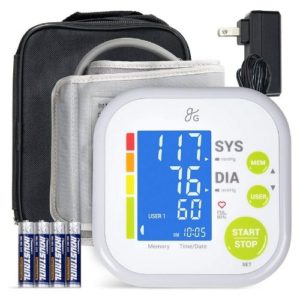 |
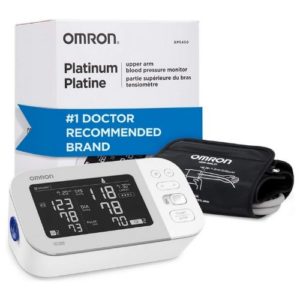 |
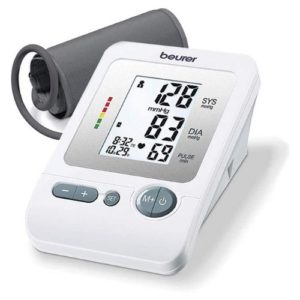 |
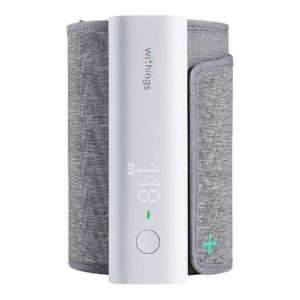 |
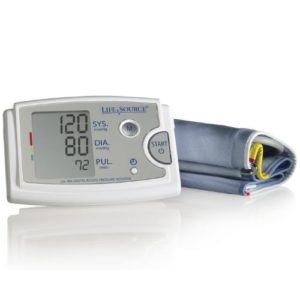 |
| $54.95 | $75.00 | $29.99 | $99.95 | $119.90 |
| Upper Arm | Upper Arm | Upper Arm | Upper Arm | Upper Arm |
| 2 | 2 (unlimited in app) |
4 | 1 | 1 |
| 60 (per user) |
100 (per user) |
30 (per user) |
8 (unlimited in app) |
60 |
| 8.75–16.5 in. | 9.0–17.0 in. | 8.7–16.5 in. | 9.0–17.0 in. | 16.5–23.6 in. |
| 4 AAA Batteries, Wall Plug |
4 AA Batteries, Wall Plug |
4 AA Batteries | Rechargeable Battery | 4 AA Batteries, Wall Plug |
| Yes ✓ |
Yes ✓ |
Yes ✓ |
Yes ✓ |
Yes ✓ |
| No X |
Yes ✓ |
No X |
Yes ✓ |
No X |
| View on Amazon | View on Amazon | View on Amazon | View on Amazon | View on Amazon |
*Amazon.com list price as of 05/15/2020 at 4:37 p.m. (MT). Read full disclaimer.
Our Approach
We started our evaluation by looking over prices, user reviews, and doctor recommendations. Here are some things we looked at when selecting blood pressure monitors for our list:
- Simple Interface: A user-friendly interface with large numbers and big buttons makes it easier to navigate the blood pressure monitor and understand the results.
- Multiple Users: A multiple-user feature tracks more than one person’s blood pressure, so you can share the monitor with family members and skip the hassle of buying multiple devices.
- Accurate Readings: Accuracy is one of the most important things to look for in a blood pressure monitor. We chose only upper arm monitors for our list because they tend to have the best accuracy. Learn more about the different types of blood pressure monitors.
- Memory Storage: With high memory storage, you can log your blood pressure readings over a long period to give your doctor a better picture of your health.
Learn about how we rank products by checking out our full methodology.
Blood Pressure Monitor Reviews
1. Greater Goods BP Monitor: Best Overall
The Greater Goods BP Monitor (about $55) is accurate, versatile, and easy to use. We especially like its large, backlit display that’s easier to read than the screens on most other blood pressure monitors. The only real downside is low memory storage compared to other monitors on the market, but if that doesn’t bother you, this blood pressure cuff is a great value.
The large LCD screen makes this home blood pressure monitor incredibly user friendly. The numbers and buttons are big, so you won’t need glasses to see your results. Most online customers rave about this monitor’s accuracy, so you can trust that the results will greatly assist your doctor in managing your blood pressure.
It has a comfortable cuff that’s easy to put on and fits on most arm sizes (8.75–16.5 inches). This blood pressure machine also comes with a handy carrying bag that holds the monitor and its accessories. This is ideal for tossing in your bag for a doctor’s appointment or packing before a road trip.
There’s not much memory storage, so you won’t be able to keep an in-depth log. This Greater Goods blood pressure monitor holds no more than 60 records each for two users. Still, we think this is the best blood pressure monitor for most folks.
Pros
- Large, bright display
- High accuracy
- Comes with a carrying case
Cons
- Average storage capacity for readings
There’s a Bluetooth Version with a Mobile App
2. Omron Platinum: Most Accurate
The Omron Platinum (about $75) packs accuracy and storage into one powerful device. This blood pressure monitor comes with TruRead technology for precise results, and its mobile app can store unlimited readings from an equally endless number of users.
Even without the mobile app, the monitor tracks readings for two users, so another family member can use it. It has enough storage space for 200 readings (100 for each user). This high memory storage tracks your history longer to help your doctor know if your medication works properly.
The Omron Platinum is also very accurate because it uses advanced averaging and TruRead technology. Advanced averaging gives an average result of your last three consecutive tests for more consistent results. TrueRead takes advanced averaging a step further by performing all three readings during the same session. It’s not as fast as a regular test but helps provide precise results.
There are two downsides to this Omron blood pressure monitor: the cuff and the mobile app. The cuff tends to be larger, so it might not be as accurate if you have small arms. But the mobile app is a bigger problem, with most user reviews citing poor performance and an inability to sync readings on their smartphones properly. Overall, we recommend the Omron Platinum more for its accurate readings than its mobile app.
Pros
- Unlimited users with mobile app
- TruRead technology for improved accuracy
- Up to 200 stored readings on the device
Cons
- Limited cuff size for smaller arms
- Only two users without the mobile app
- Poor mobile app performance
A More Affordable Option from Omron
3. Beurer BM26: Best Value
If you hesitate to spend upwards of $50 or more on a blood pressure monitor, you might like the Beurer BM26 (about $30). This inexpensive blood pressure monitor doesn’t have a vast storage capacity or a backlit display like our top two picks, but it still accurately measures blood pressure.
Surprisingly, the Beurer BM26 can track blood pressure readings for up to four users, which is more than other units on our list that don’t use mobile apps. This gives you a lot of flexibility for keeping on top of your family’s blood pressure.
Each user can have up to 30 readings, which isn’t exactly an extensive history of your blood pressure. But there’s always the possibility you could use all four profiles for one person to quadruple your storage capacity.
The Beurer BM26 also has a basic averaging feature that uses readings over that last 24 hours for more accurate results. Averages present a better picture of your blood pressure levels throughout the day, so we’re glad the monitor has this feature.
Even though this blood pressure meter doesn’t have a backlit display, it still has large numbers on its display that are easy to read. Overall, we think the Beurer BM26 is an excellent option for your first BP monitor or a limited budget.
Pros
- Affordable, no-frills design
- Supports up to four users
- Averages your results over the last day
Cons
- Low storage capacity for readings
- No backlit display
Get a Backlit Screen with the Beurer BM47
4. Withings BPM Connect: Most Portable
The Withings BPM Connect (about $100) is a compact blood pressure monitor that connects to your smartphone with an excellent mobile app. The Withings app has mostly glowing reviews from users, saying it’s easy to use and presents information in an easy-to-understand way.
It’s also an attractive device that looks more like a small Bluetooth speaker than a blood pressure meter. There’s a rechargeable battery that lasts up to six months on a charge, which goes perfectly with the small size to make this BP monitor ideal for trips or even just carrying around in a bag during errands.
The device has both Bluetooth and Wi-Fi connections to sync your readings. The Wi-Fi is especially helpful because the BPM Connect automatically stores your readings online. This convenient feature streamlines the way you track your blood pressure level and simplifies sharing results with your doctor.
This Withings blood pressure monitor stores an abysmal eight readings—the lowest capacity on our list. While this isn’t a problem as long as you have internet access, it makes the unit a little harder to take on trips. This monitor technically supports multiple users, but switching the device between users with different Withings accounts isn’t a smooth process. You may want to keep this to a single user.
Despite its relatively high price compared to other BP monitors, we think the Withings BPM Connect is a great portable option for people that love smart tech.
Pros
- Compact design
- Excellent mobile app
- Unlimited cloud storage for your readings
Cons
- Only holds eight readings
- Best as a single-user device
- Expensive
Reading the Display on the Withings BPM Connect
5. LifeSource: Best Cuff Size Options
LifeSource by A&D Medical stands out because its cuffs come in a wide range of sizes to fit all kinds of folks. If you have a big arm and struggle to squeeze yourself into tiny little cuffs, you’ll appreciate the size of LifeSource (Extra Large Cuff) (about $120). Finding the right cuff makes a big difference in accurately gauging your blood pressure levels.
We like the LifeSource extra large cuff because it fits arms (16.5–23.6 inches) that are too big for every other BP monitor on our list (about 9.0–16.5 inches). This is great for people with particularly muscular builds because they don’t have to settle for less accurate readings from a wrist- or finger-type blood pressure monitor.
LifeSource is one of the most accurate blood pressure monitor brands on the market, with countless online reviews praising its accuracy. Another nice feature is that it alerts you if it detects irregular heartbeat patterns so you can contact your doctor or seek medical attention if it becomes a problem. Still, this feature isn’t unique to LifeSource since all of the BP monitors we recommend have it.
One big miss on this blood pressure monitor is the memory storage. It stores only up to 60 readings, which is average compared to other monitors on the market. While this is acceptable on cheaper devices, it’s not great on a single-user device that costs over $100.
Ultimately we think this is an excellent option if you don’t fit the average arm circumference of most people.
Pros
- Extra-large arm cuff
- Accurate readings
- Irregular heartbeat detector
Cons
- Expensive
- Average storage capacity for readings
For Smaller Arms
Final Word
There’s no prescription required to buy a home blood pressure monitor, so you’re left on your own to choose the right one. But we think it doesn’t have to be a hard decision if you go with the Greater Goods BP Monitor. This blood pressure meter is easy to use and produces accurate results to track your blood pressure easier than ever.
Using a blood pressure monitor is just one way to improve your health so you can live a safer, more active life. Find more ways to look after your wellness and keep your household safe with our extensive safety resources covering everything from medical alert devices to carbon monoxide detectors.
How to Use a Blood Pressure Monitor
Steps to Use a Digital Blood Pressure Monitor
Take an accurate in-home blood pressure reading by following the steps below:
- Get ready. Make sure you’re comfortable and relaxed. Your bladder should be empty, as a full one can impact the reading. Avoid smoking, exercise, and caffeine before taking your blood pressure.
- Sit down. A comfortable sitting position is also the best position for taking a blood pressure reading. Remove any clothing that is tight or bulky around the upper arm, or roll up your sleeve. Place both feet on the floor (no crossed legs!) and rest your forearm comfortably on a table at heart level. Place your arm with the palm of your hand facing up.
- Find your pulse. Locate the brachial artery by finding your pulse in the center of your elbow. Press your index and middle fingers lightly against the inside of your elbow. If you can’t find it by feeling, use the upper arm cuff to locate your pulse.
- Use the right sized cuff. For an accurate reading, you need a blood pressure cuff that fits correctly. The length of the cuff should equal at least 80% of the circumference of your upper arm.
- Apply the blood pressure cuff. Wrap the cuff around your upper arm (it might help to have someone assist you). The lower edge of the cuff should be about one inch above the pit of your elbow. The cuff should feel snug, but not tight.
- Power up the monitor. Press the power button on your automatic blood pressure monitor to turn it on. You should see all the display symbols flash on the screen, followed by a zero. The zero means that the monitor is ready for action.
- Inflate the cuff. Press the start button if your digital monitor has automatic cuff inflation.
- Get your readings. Watch the monitor for the pressure readings. They will display on either the left or right side of the screen. You’ll hear a long beep, which means the blood pressure measurement is complete. Take note of the pressures on the display.
- Systolic pressure should be on the left or the top of the screen.
- Diastolic pressure should be on the right side of the screen or just below the systolic reading.
- The monitor may also display your pulse rate.
- Many monitors also track if there’s an irregular heartbeat, which may indicate undiagnosed health issues.
- Finally, allow the cuff to deflate completely before taking it off.
What Do Systolic Pressure and Diastolic Pressure Mean?
What to Do If Your Reading Is Inaccurate
Sometimes you’ll get a BP measurement that just doesn’t make sense. This is fairly common, especially when you’re new to home blood pressure monitoring.
If you didn’t get an accurate reading, don’t immediately re-inflate the blood pressure cuff. Remove the cuff and give yourself at least one minute before reapplying the cuff and repeating the steps to measure your blood pressure.
The American Heart Association recommends taking your new home blood pressure monitor with you to your next doctor’s appointment.1 You can ask questions, and your doctor can make sure you’re using the monitor correctly.
You can also verify that your home monitor gets the same results as the equipment in your doctor’s office. It’s good practice to bring in your home monitor at least once a year to make sure readings are still accurate.
Blood Pressure Basics
- Normal
- Prehypertension
- Stage 1 hypertension
- Stage 2 hypertension
Consistent Blood Pressure Monitoring Is Key
Staying on top of your blood pressure is important, but it doesn’t have to be difficult. With the right home blood pressure monitor, it’s easy to keep your health in check.
By partnering with your doctor to keep an ongoing record of your blood pressure between appointments, you’re more likely to get the right recommendations and medications.
Blood Pressure Monitor FAQ
What are the different types of blood pressure monitors?
There are three methods for measuring blood pressure: arm monitors, wrist monitors, and finger monitors.
- Arm Monitors are the only type recommended by the American Heart Association because they’re the most accurate.2 The cuff wraps around the upper part of your arm and tightens to measure your blood pressure.
- Wrist Monitors wrap around your wrist to measure your blood pressure. These aren’t considered as accurate as upper arm monitors unless you have your arm and wrist positioned exactly at heart level. You must follow the manual very closely because there’s a lot of room for error. Wrist monitors are easy to travel with and can be more comfortable than upper arm monitors.
- Finger Monitors are very similar to wrist monitors. They’re small, easy to travel with, and more comfortable than an upper arm monitor. Again, the main shortcoming is that it’s not the most accurate.
You want to pick the best type for your needs that also meets your doctor’s recommendations.
Will my insurance cover my blood pressure monitor?
Most health insurance plans do not cover blood pressure monitors. Medicare will most likely not cover the cost of one either. Thankfully, there are plenty of affordable options available through sellers like Amazon.
Qualified Expenses
Should I buy a used blood pressure monitor?
While many used blood pressure monitors are available, it’s a good idea to buy a new one. The accuracy and reliability of your blood pressure monitor can determine your hypertension care course and may save your life. You want to make sure your machine works correctly.
Checking Your Monitor’s Accuracy
My doctor wants me to get my blood pressure monitor calibrated. What does that mean?
Not all blood pressure monitors are the same. Just like any instrument, there are slight differences between the different models. Calibrating your blood pressure monitor involves taking it to your doctor’s office to verify that readings match the monitors in their office.
I use the DASH diet to control my blood pressure. Do I really need a monitor?
The DASH diet (and others like it) are great choices for managing your blood pressure, especially under the supervision of your doctor. But they don’t replace the need for a blood pressure monitor because you still need to take accurate and frequent readings to see if the diet works.
I’ve heard a wrist blood pressure monitor may be more comfortable and easy to use. Should I buy one of those?
In general, wrist monitors aren’t as accurate as upper arm cuffs. Some patients prefer to use a cuff that sits on the wrist because it’s easier to use with one hand.
All of the upper arm cuffs we recommend are easy to put on and use with one hand.
I bought a blood pressure monitor, but the cuff is too small. Can I buy a bigger cuff, or do I need to buy a whole new blood pressure monitor?
Most blood pressure monitors come with a one-size-fits-most cuff for upper arms measuring 9.0–16.5 inches. Getting a blood pressure cuff that fits right is critical for accurate readings.
If your upper arm measures more than 16.5 inches around, you should get a bigger cuff. You can usually purchase extra cuffs separately, and most are compatible with various blood pressure machines. Just make sure your tubing is the correct size to connect with your monitor.
My doctor told me I have high blood pressure. Can I use my Fitbit or smartwatch to monitor my blood pressure?
While Fitbits and smartwatches are great for tracking general fitness data, like steps taken and pulse rate, they aren’t accurate or reliable enough for monitoring high blood pressure. In fact, most heart monitors for exercise only track your heart rate. They simply can’t take the correct measurements.
The only proper way to take your blood pressure involves sitting down for at least a few minutes with both feet flat on the floor and your arm resting at heart level. For more recommendations for proper use, see the American Heart Association’s recommendations for monitoring your blood pressure.
Sources
- American Heart Association, “Monitoring Your Blood Pressure at Home”
- American Heart Association, “Monitoring Your Blood Pressure at Home”
Disclaimers
*Amazon.com list price as of 05/15/2020 at 4:37 p.m. (MT). Product prices and availability are accurate as of the date/time indicated and are subject to change. Any price and availability information displayed on Amazon at the time of purchase will apply to the purchase of this product. Safewise.com utilizes paid Amazon links.
Certain content that appears on this site comes from Amazon. This content is provided “as is” and is subject to change or removal at any time.
The post 2020 Best Blood Pressure Monitors Buyers Guide appeared first on SafeWise.


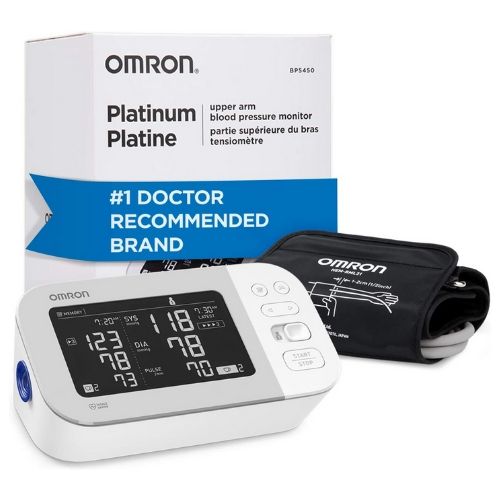
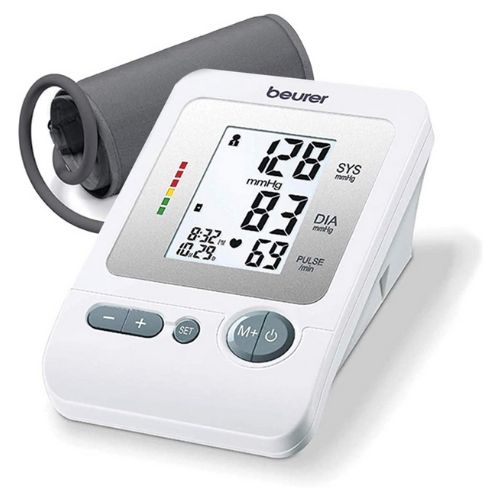
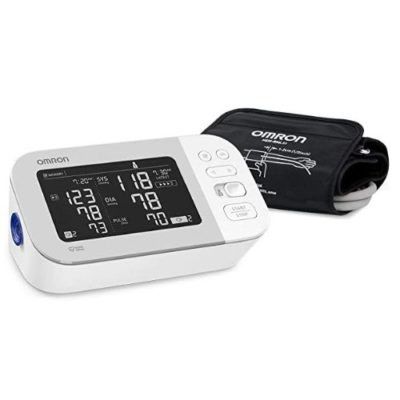
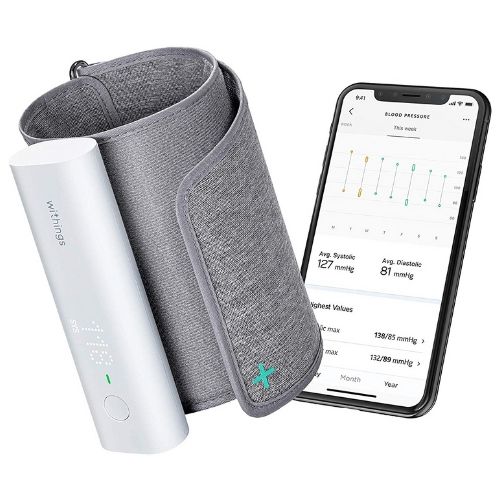
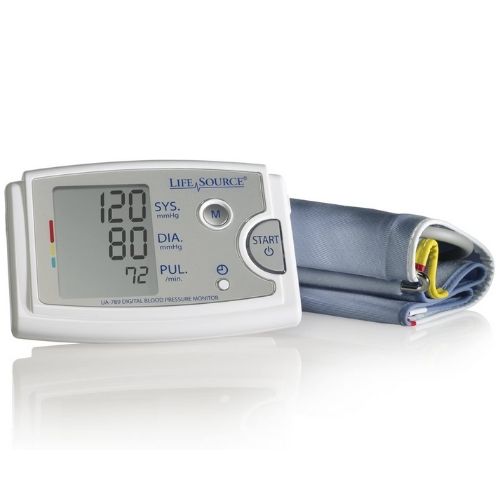
No comments:
Post a Comment